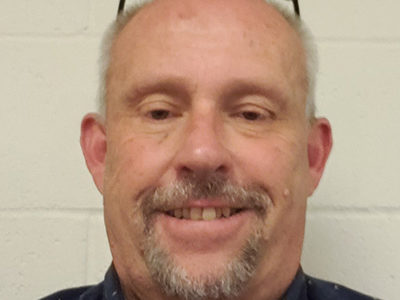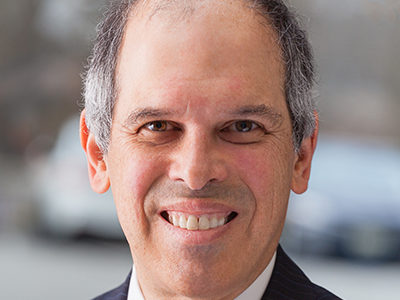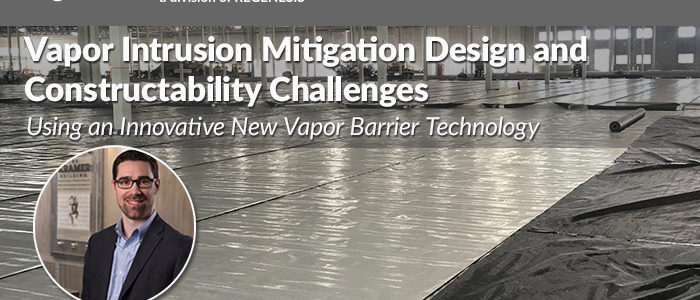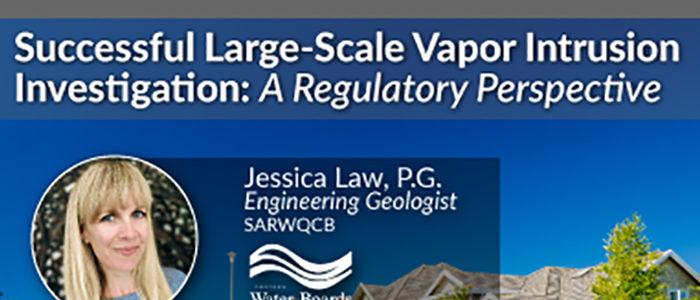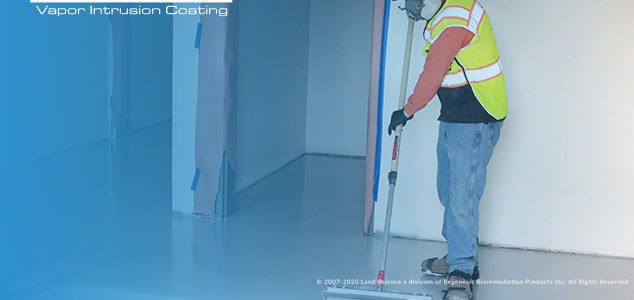The Evolution of Vapor Barrier Technology and Best Practices for Successful Vapor Barrier Implementation
Learn the following in this free webinar:
- The evolution of vapor barrier technology
- How vapor barriers originated from waterproofing materials, and now incorporate advanced formulations resulting in more protection for building occupants
- Strategies for successful vapor barrier implementation
- Methods to ensure a high-quality vapor barrier installation
In this webinar we are pleased to have a special presentation by Scott Wilson, President & CEO of REGENESIS and Land Science, and Ryan Miller, East Region Manager for Land Science. They discussed the evolution of vapor barrier technology, as well as best practices for successful vapor barrier implementation.
View webinar
Complete the form below to sign up for this free webinar.
Client Spotlight: Frank Poss, Department Manager/Senior Geologist for Intertek-PSI
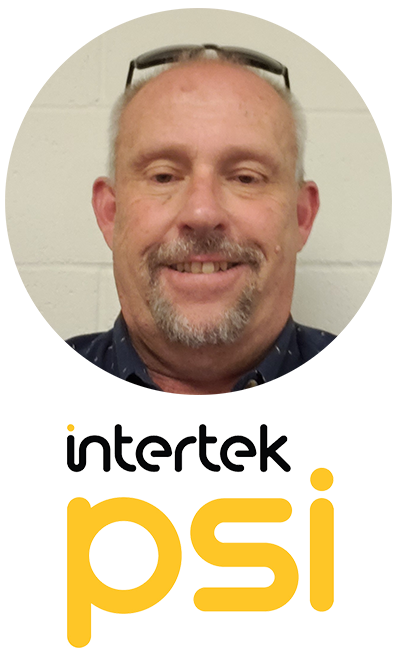 Ask Frank Poss, Department Manager/Senior Geologist for Intertek-PSI, a nationally recognized environmental consulting firm and valued Land Science® client, what he enjoys most about his work, and you will likely learn why he is such a valuable asset to Intertek. That’s because his role covers such a diverse range of responsibilities and allows him to leverage his nearly 30 years of professional environmental experience. As Department Manager, he effectively manages several aspects of the business- from accounting to HR to project management, and more. He shares, “I have a plethora of responsibilities. These include the profit and loss of my department, operating Human Resources, managing accounting, and addressing most technical issues. I also oversee and approve all the proposals that are generated from the office, as well as developing proposals myself. I take pleasure in the fact that I complete something different every day I walk in the door. The wide range of responsibilities fits my personality.” To prepare for a career in environmental remediation, Poss earned his BA in Geology from University of California Santa Barbara. He then embarked on his MS in Geology from San Diego State University, during which time the environmental industry took off. He continues, “Ultimately, my career kind of chose me. Coming out with my BA from UC Santa Barbara there were not many jobs for Geologists, so I went back for my Masters. While working on that, environmental work exploded, so many geologists went where the work was and that was environmental. My timing was right on.” Prior to joining Intertek, he held positions as a Staff and Project Geologist for environmental services companies, primarily on the West Coast.
Ask Frank Poss, Department Manager/Senior Geologist for Intertek-PSI, a nationally recognized environmental consulting firm and valued Land Science® client, what he enjoys most about his work, and you will likely learn why he is such a valuable asset to Intertek. That’s because his role covers such a diverse range of responsibilities and allows him to leverage his nearly 30 years of professional environmental experience. As Department Manager, he effectively manages several aspects of the business- from accounting to HR to project management, and more. He shares, “I have a plethora of responsibilities. These include the profit and loss of my department, operating Human Resources, managing accounting, and addressing most technical issues. I also oversee and approve all the proposals that are generated from the office, as well as developing proposals myself. I take pleasure in the fact that I complete something different every day I walk in the door. The wide range of responsibilities fits my personality.” To prepare for a career in environmental remediation, Poss earned his BA in Geology from University of California Santa Barbara. He then embarked on his MS in Geology from San Diego State University, during which time the environmental industry took off. He continues, “Ultimately, my career kind of chose me. Coming out with my BA from UC Santa Barbara there were not many jobs for Geologists, so I went back for my Masters. While working on that, environmental work exploded, so many geologists went where the work was and that was environmental. My timing was right on.” Prior to joining Intertek, he held positions as a Staff and Project Geologist for environmental services companies, primarily on the West Coast.
When it comes to working with Land Science, Poss appreciates their collaborative approach to finding the most effective solutions. “I have really enjoyed working with Land Science on several vapor intrusion projects,” he says. “I especially enjoy that they do not act like a subcontractor, but as a partner trying to solve a problem for a client.” With regard to specific Land Science products, Retro-Coat™ and Geo-Seal™ have been used successfully on a variety of projects. Poss continues, “Retro-Coat was great for an existing building in San Francisco, where the building took up the entire footprint of the property. As part of a property transaction, it was determined that the subject property was formerly a dry cleaner with elevated concentrations of PCE found indoors. Working with Land Science, we were able to apply Retro-Coat in a basement and in a restaurant above, and reduce the levels of PCE to below regulatory action levels.”
When asked about his goals for Intertek, he emphasizes the importance of growth and profitability, while maintaining a fun and productive company culture. He continues, “My goals are to continue to expand, while having a good time doing so. I find that having a great team around me is crucial because it stimulates productivity, thereby increasing profitability. I believe people who enjoy their work environment are much more productive. In fact, my number one criterion during hiring is finding people I want to be around beyond the typical 40-hour work week, since in many ways, we are a second family.”
Residing in Northern California with his wife of 27 years, Poss works out of the Intertek-PSI Oakland office, and has worked in Long Beach, San Francisco, and Oakland. “I have spent half my career in Southern and Northern California.” When asked what he enjoys most about his work, he points to an appreciation for the variety in his everyday responsibilities. He continues, “I enjoy having different challenges every day and getting to share those challenges with a great group of people. I am definitely not someone who wants to know that I will be sitting down and doing the same thing over a long period of time. Rather, I prefer juggling lots of balls and feel I excel most when a number of things are going on.” And the most challenging aspect of his job? “I would say human resource issues. I have been extremely fortunate that over the years I have had very few HR issues to deal with. However, when they have risen, we have worked through them in a positive and productive way.”
Away from work, Poss enjoys travelling, playing golf, reading, coaching, and is a self-confessed foody. “The reason we work is to enjoy the things outside of work. For travel, my favorite destination is Paris. I have had the good luck of being there three times and each time was more enjoyable. First of all, Paris is beautiful with the Seine and all the wonderful parks. It has tons of history and some of the best art galleries in the world- I especially love the Orsay. Most of all, Paris turned me into a foodie. From a Michelin star restaurant to the fruit stand on the corner, you cannot go wrong.” His coaching experience includes both competitive soccer and baseball. He continues, “Coaching has been the best experience of my life. Kids can be very competitive when striving to get better, and I love seeing the joy that players have in doing things. Coaching was also a great way to be part of my kids’ lives in a different dynamic compared to just being a dad.”
When asked what he sees the future holds for environmental remediation, Poss feels the inevitability of continued property transactions, coupled with California’s increasing vapor regulations, will keep the statewide industry busy indefinitely. He shares, “With vapor intrusion and the now incredibly low regulatory limits, we are telling clients in industrial areas to just assume they are going to need to place a vapor barrier as part of their construction plan. If they do not need one, then that’s a bonus of sorts.” He’s also noticed that while the industry has evolved over the past three decades, the importance of teamwork has not changed much. “Obviously, the industry has changed a lot, but the same things hold true. Working with clients on solutions to their problems and working as a team to solve them is still the same. This is how you end up with a working relationship that can last decades. I would say as technology and work styles have evolved, that people do not pick up the phone as much as they used to. A one-minute call can typically solve an issue that might not be solved over 10 e-mails.” And how would he encourage others to join his field of study? He concludes, “I would encourage anyone who is going into any science field to write, write, write. I spend most of my day writing and was very unprepared coming out of college. Being able to write well is a skill that is hard to teach and is typically critical as you ascend within an organization.”
Land Science is proud to have Frank Poss, Department Manager/Senior Geologist for Intertek-PSI , as a valued client and partner in environmental remediation, and appreciates his diverse background and commitment to providing successful remediation outcomes for Land Science and its clients.
Industry Expert Spotlight: Ben Alter, Principal at GZA

When the U.S. oil industry collapsed in the mid-1980s, Benjamin Alter, at the time an Exploration Geophysicist with Chevron, was prepared to rebound. He quickly leveraged his passion for the earth’s sciences into a second career in environmental remediation. Now a Senior Vice President and Principal of GZA GeoEnvironmental, Inc., a leading environmental engineering and consulting services firm, Alter has amassed a deep reservoir of applied experience, which includes serving 22 years at GZA alone, as well as authoring a book, Environmental Consulting Fundamentals. Alter is in many ways contributing to help sustain our environment, while also impacting the future success of GZA. He continues, “My general role at GZA is what I refer to as a “Seller-Doer,” which means that I’m responsible for bringing clients and projects to GZA and then managing them. Each project typically has a Project Manager who reports directly to me, and other staff that reports to the project manager. I’m also responsible for limiting GZA’s liability on a given project, project invoicing, and collections.” In addition to his role as principal, he is also co-chair of GZA’s Environmental Site Investigation technical practice. In this capacity he oversees the integrity of the practice and ensures that GZA practitioners are properly trained and equipped.
To prepare for a career in earth sciences, Alter earned his BS from State University New York/Albany (SUNY), where he double-majored in Geology and Mathematics. He followed that with an MS in Geophysics from Cornell University, and later earned an MBA from Columbia University. To stay abreast of industry trends and evolving technology, he completes required coursework, as mandated by the state of New Jersey. He continues, “As a Licensed Site Remediation Professional (LSRP) I’m required to take 36 credits of continuing education courses over a 3-year cycle. These courses must contain a mix of technical and regulatory oriented courses as well as an ethics course.” In addition, he teaches two continuing education courses, one regarding environmental due diligence in New Jersey and one on technical writing.
Through the years, he’s noticed how the industry has evolved, from a focus on legacy sites (those properties that had become contaminated before the advent of environmental regulations) to Brownfields. He shares, “When I initially started environmental consulting, most of my work involved cleaning up legacy sites and environmental compliance work for industries. However, because of the de-industrialization of the greater New York City area, I now do very little work for industrial clients. While there are still plenty of legacy sites to clean up, more and more of my work is focused on redevelopment of inner-city properties, such as Brownfields.” When asked what he enjoys most about working with REGENESIS, he feels they offer a strong combination of service, product, and value. “I’ve worked on several projects with REGENESIS,” he says. “Their products are effective and competitively priced and their staff is consistently very helpful. As for specific product usage, I’ve used ORC® Advanced on sites, and GZA as a company has used a wide range of REGENESIS’ products over the years.”
Alter works out of GZA’s northern New Jersey office in Fairfield, a short 10-minute drive from home. In his free time he sings in two choirs and is the piano accompanist for a variety group called “The Loose Canons” (theloosecanons.org). “I also write parodies and arrange songs, and write my synagogue’s annual play. In addition, I’m an avid cyclist, hiker, and racquetball player.” To give back to the community, he sits on the Board of Trustees of the LSRP Association and chairs its College Outreach Committee. He continues, “I’m also a board member and founder of the LSRPA Foundation, which provides scholarships to students and grants to environmental organizations. Earlier this year, I had the pleasure of handing out $25,000 in checks to nine young people with terrific futures in environmental remediation.” When asked what he likes most about his work, the human aspect quickly comes to mind. He shares, “My favorite part of my job is the people – my co-workers especially. GZA nurtures a great family vibe – people really care about each other. It’s a demanding job, so having the support of your colleagues helps everyone get through the day. As one of the senior people in the office, I particularly enjoy mentoring the younger staff and watching them grow as professionals.” In his leadership role, he is also able to play a key role in the overall success of the company. He shares, “Our objective is to grow organically and by acquisition, focusing on increasing our geographical coverage, expanding our technical services, and bringing in expertise to augment our existing technical services.”
When asked how he’s seen the industry evolve over the years, he points to how the consulting aspect has matured, with numerous high quality, seasoned competitors, and how the LSRP program brought about change. He continues, “The LSRP program in New Jersey, which began in 2009, was a paradigm shift, since it allowed licensed people like me to investigate, remediate, and close spill cases with minimal involvement from the regulatory agencies.” And how would he encourage others to join his field of study? He concludes, “The LSRPA College Outreach Committee encourages students to pursue careers in environmental consulting by offering a variety of services that include on-campus presentations, webinars on resume building and job interview skills, and managing a resume portal where students can post their resumes for LSRPA members to access. And of course, the scholarships I mentioned earlier are a terrific benefit as well. I would suggest if someone is interested in this field, they take advantage of as many resources as possible.”
REGENESIS is proud to have Benjamin Alter, Senior Vice President and Principal of GZA GeoEnvironmental, Inc., as a valued client and partner in environmental remediation, and appreciates his exceptional experience and dedication in providing successful remediation outcomes for REGENESIS and its clients.
Vapor Intrusion Mitigation Design And Constructability Challenges: Using An Innovative New Vapor Barrier Technology
Learn the following in this free webinar:
- Use of a reliable, cost-effective vapor mitigation solution allowed client to meet milestones and stay on time and on budget
- Sites required a vapor barrier that was resistant, with documented diffusion coefficients, to low level TCE and methane that could be approved by Michigan’s Department of Environment, Great Lakes & Energy (EGLE)
- Collaboration between EGLE, local community leaders and the developer ensured a smooth and successful result
- Traffic control program minimized barrier damage during construction and the enhanced smoke testing program successfully identified areas requiring repair
In this webinar we are pleased to have as a special guest speaker Mark Quimby, Senior Consultant at SME. His presentation discussed overcoming vapor intrusion mitigation design and constructability challenges at two large industrial sites using an innovative new vapor barrier technology. The sites discussed were new buildings approximately 575,000 square feet (SF) each, on two different, but similar, former landfill sites. He is joined by Ryan Miller, East Region Manager at Land Science, who discussed technologies to mitigate vapor intrusion.
View webinar
Complete the form below to sign up for this free webinar.
TerraShield Mitigates Vapor Intrusion on Former Industrial Site
Project snapshot highlights:
- The former industrial site required an effective vapor mitigation solution to move the federally funded project forward
- The consultant determined TerraShield was the safest and most cost-effective vapor barrier system to install at this site
- The installation of TerraShield was completed on schedule and the site is currently pending closure (NFA)
A former industrial site located in Southern California was targeted for redevelopment and chosen to be developed into a federally funded public site. Historical operations left the original property contaminated with petroleum hydrocarbons and volatile organic compounds (VOCs). In addition to the presence of these contaminants, new buildings constructed in the area are required to feature a vapor intrusion mitigation system due to the presence of methane gas in the soil, which may eventually enter unprotected buildings on the surface. Because of these factors and the completed site’s intended purpose for public use, an effective vapor mitigation system was necessary.
Successful Large-Scale Vapor Intrusion Investigation: A Regulatory Perspective
In this webinar we are pleased to a special presentation from Jessica Law, engineering geologist and case manager for the Santa Ana Regional Water Quality Control Board. This presentation discussed a case study outlining the largest residential vapor intrusion investigation in California at the site of a former aerospace manufacturer. Ms. Law provides a thorough overview of the team’s effort to manage both community concerns and changing regulatory guidelines as it applies to this challenging investigation. Joining Ms. Law was Thomas Szocinski, CEP Land Science Director of Vapor Intrusion, who shared effective approaches to mitigating vapor intrusion on sites like the one discussed in the featured case study.
Recording now available
Complete the form below to view the recording of this free webinar.
Client Spotlight: Greg Page, Senior Engineer with Environmental Consulting & Technology, Inc.
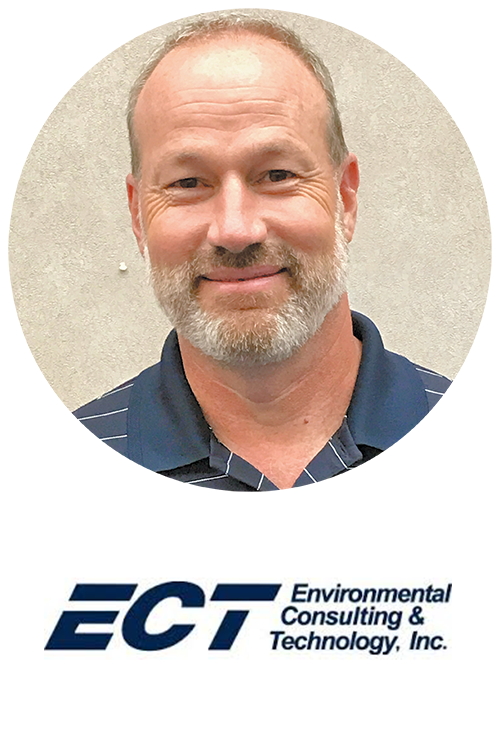 For Greg Page, Senior Engineer with Environmental Consulting & Technology, Inc. (ECT), a valued Land Science® client, working as a team to solve challenging environmental issues is a daily reminder of why he chose to pursue a career in bioremediation. He begins, “To partner with a client as a team versus just being a hired vendor is very satisfying. A true partnership facilitates a thorough understanding of stakeholder objectives, the ultimate end use of the property, and knowing the community impact leads to effective evaluation of remedial technologies so that the proposed application solves the right problem.” Greg’s commitment to his work and, more specifically, to fostering collaborative client relationships, spans 30+ years. He began his career in 1989 as a Remediation Engineer with a regional environmental services company, before joining a global design and consultancy in 2006 as a Resource Manager. He was promoted to Operations Leader in 2012, and later joined ECT in 2015 in his current role.
For Greg Page, Senior Engineer with Environmental Consulting & Technology, Inc. (ECT), a valued Land Science® client, working as a team to solve challenging environmental issues is a daily reminder of why he chose to pursue a career in bioremediation. He begins, “To partner with a client as a team versus just being a hired vendor is very satisfying. A true partnership facilitates a thorough understanding of stakeholder objectives, the ultimate end use of the property, and knowing the community impact leads to effective evaluation of remedial technologies so that the proposed application solves the right problem.” Greg’s commitment to his work and, more specifically, to fostering collaborative client relationships, spans 30+ years. He began his career in 1989 as a Remediation Engineer with a regional environmental services company, before joining a global design and consultancy in 2006 as a Resource Manager. He was promoted to Operations Leader in 2012, and later joined ECT in 2015 in his current role.
He continues, “I work with project managers to develop remedial alternatives to meet client objectives and satisfy regulations. Holistic planning is paramount in our approach, and seeing properties returned to beneficial use is satisfying.” Greg’s initial interest in environmental remediation was sparked, in part, by the experience he had while working during the summer with his best friend’s mother, who happened to be an independent geologist. “After seeing the results of assessment through cleanup at some petroleum sites, I was hooked,” he says. He subsequently decided to focus his university studies on the environment as well as civil planning, attending Tennessee Technological University, where he graduated with a BS in Civil Engineering.
Although he possesses three decades of experience in his field, Greg realizes the industry is constantly evolving. Understanding the importance of staying current on new technology and emerging trends, he makes an effort to regularly attend webinars, presentations and conferences to share and learn new applications and remedial strategies. He continues, “Land Science Webinars, along with other technology leaders, have been extremely beneficial, and it is always refreshing to see new applications in different situations. The recent webinar entitled “RetroCoat 101” was especially helpful in explaining options to regulators on a South Florida project.” When asked why he enjoys working with Land Science, Greg points to the company’s vast expertise in solving vapor intrusion challenges. He explains, “Their approach to design and application is straightforward, which facilitates smooth communication to clients and regulators. We recently installed TerraShield® at an expanding car dealership in South Florida and Land Science integrated the solution within a tight construction schedule that exceeded the client’s expectations. Historically, we have used Geo-Seal at most of our brownfield and new construction sites requiring vapor mitigation.” When asked what he sees the future hold for environmental remediation, he points to the likelihood of further adoption of risk-based solutions. He shares, “While applicable in some cases, the resources spent to remediate some sites to low concentration levels can be high. In addition, future use evaluations can create lost opportunities to utilize those resources for better and higher use.” He also realizes that while there is much about his work he enjoys, he concedes there are challenges. “We are constantly balancing project completion demands with internal continuous improvement and training opportunities. This creates a healthy tension that can be demanding, but with focus and discipline, the work can be rewarding.”
Residing in Knoxville, TN, where he works out of one of ECT’s 22 offices, Greg enjoys his time away from work. “I have two grandsons,” he shares. “From hunting to dirt bikes to fishing, they keep me pretty busy, on the farm.” Barbecuing, mountain biking, kayaking, and hiking are especially high on the list. He adds, “We are also fortunate to live close to the Great Smoky Mountains and Big South Fork.” When asked how he’s seen the industry change over the years, he feels complete site restoration may not be practical in every situation. He shares, “Over the course of the last 30 years, the remediation industry has recognized that returning a contaminated site to its original state is often neither necessary nor possible, and often limited by financial resources. Fortunately, the industry and regulators have responded with risk-based applications, including vapor barriers, that allow many long-time blighted properties to return to beneficial reuse.” And how would he encourage others to join his field of study? He concludes, “I would suggest seeking out internships and meetings with industry experts, both managerial and technical, to understand the many aspects of environmental engineering and remediation. From there, one can decide which particular area is of most interest.
Land Science is proud to have Greg Page, Senior Engineer with Environmental Consulting & Technology, Inc., as a valued Land Science® client, and appreciates his wealth of experience and dedication in providing successful remediation outcomes for Land Science and its clients.
Client Spotlight: Scott Kurtz, Ninyo & Moore
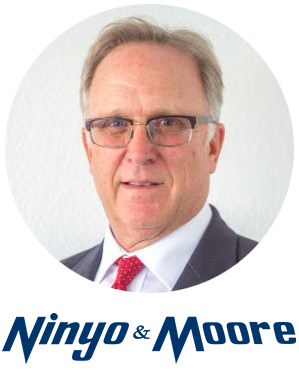 With more than 30 years of experience at Ninyo & Moore Geotechnical and Environmental Sciences Consultants, Inc., a leading environmental services firm and valued Land Science® client, Scott Kurtz has been involved in nearly every facet of the company’s business. As its Director of Environmental Sciences, he is responsible for the performance and growth of the company’s Environmental Divisions, which includes overseeing work across 18 offices in Arizona, California, Colorado, Nevada, Texas, and Utah. He shares, “We have eight environmental divisions- from San Diego to Alameda in California, and across the Southwest to Houston, Texas and Denver, Colorado. As Director, Environmental Sciences I’m responsible for business development, growth, recruiting and profitability. In addition, I’m also focused on strategic positioning and in assisting all of the environmental divisions with top line issues.” Since starting with the company in 1988 as a Project coordinator, Kurtz has steadily progressed through the company’s ranks. He was promoted to Principal Environmental Scientist, then to Manager of Environmental Sciences of the firm’s Irvine office, before being tapped for his current Director position.
With more than 30 years of experience at Ninyo & Moore Geotechnical and Environmental Sciences Consultants, Inc., a leading environmental services firm and valued Land Science® client, Scott Kurtz has been involved in nearly every facet of the company’s business. As its Director of Environmental Sciences, he is responsible for the performance and growth of the company’s Environmental Divisions, which includes overseeing work across 18 offices in Arizona, California, Colorado, Nevada, Texas, and Utah. He shares, “We have eight environmental divisions- from San Diego to Alameda in California, and across the Southwest to Houston, Texas and Denver, Colorado. As Director, Environmental Sciences I’m responsible for business development, growth, recruiting and profitability. In addition, I’m also focused on strategic positioning and in assisting all of the environmental divisions with top line issues.” Since starting with the company in 1988 as a Project coordinator, Kurtz has steadily progressed through the company’s ranks. He was promoted to Principal Environmental Scientist, then to Manager of Environmental Sciences of the firm’s Irvine office, before being tapped for his current Director position.
Although his career in environmental sciences spans more than three decades, Kurtz’s initial career path began by serving his country in naval ship repair. It was during this time that an opportunity surfaced that offered him a manager position with an industrial waste management/tank cleaning/decommissioning firm. He continues, “While working in that capacity, around 1986-87, environmental regulations began to ramp up regarding hazardous waste handling and disposal. Between 1986-1988, I transitioned that company from a Navy ship repair subcontractor to a waste management/disposal and cleanup firm. It proved to be a unique way to launch a career.” To bolster his knowledge of environmental sciences, and in particular hazardous waste, Kurtz earned his Professional Certificate in Hazardous Materials Management from the University of California San Diego Extension. To stay on top of developing technological issues in his field, he subscribes to several industry publications, and regularly participates in webinars, workshops, and conferences, with many offered through the US Environmental Protection Agency and the California EPA. He points to the recent 2019 USEPA Brownfield Conference in Los Angeles as one that was especially productive. “It was great a conference for information sharing, gathering and networking. Approximately 2,000 attendees from across the country were present, and a few international contingencies gathered to share Brownfield redevelopment experiences and best practices.” In addition, he participates in economic development and urban redevelopment organizations, webinars, workshops and conferences, and is a member of the California Association of Local Economic Development (CALED). He also serves on their Economic Development, Finance and Real Estate committee.
As one who has garnered so much experience throughout his career with Ninyo & Moore, Kurtz can look back with pride, knowing he has contributed greatly to the success of the company, and yet he also keeps an eye forward. He shares, “I’d like to continue helping the company achieve its goal of creating a rewarding, high quality environment for our professional staff to work in, while simultaneously maintaining our high standards for project performance and client satisfaction. In addition, we want to look for growth opportunities which target new geographic locations when opportunities arise.” When it comes to working with Land Science, Kurtz appreciates the company’s technical prowess and its commitment to providing superior service. He continues, “We work with Land Science on a variety of vapor barrier projects and have purchased and installed several of their products. I know that historically, on the REGENESIS® side, we have used ORC® products in groundwater hydrocarbon remediation projects. Both the REGENESIS and Land Science staff have always provided access to very good technical data and they offer top notch service and support.” When asked about the most rewarding aspect of his work, he points to the opportunity of working with so many dedicated, talented professionals at Ninyo & Moore. “I also enjoy seeing the growth we’ve had and the reputation that our company has developed through the years.” And the most demanding part of his job? “Finding qualified, young professionals to join us can be challenging. Another tough aspect is competing for work in the public works and local government markets- it can be extremely competitive.”
Residing in San Juan Capistrano, CA with his wife, Kurtz works out of the Ninyo & Moore Irvine office, and travels extensively to the company’s various offices to direct and manage the firm’s eight environmental divisions. Outside of work, he enjoys spending time with his family including his wife Shelly, two grown daughters and their husbands and two grandsons, golfing, sailing, boating, traveling, collecting albums, listening to music, and attending rock ‘n roll concerts. Favorite golf courses he’s played include Pebble Beach and those in the Hawaiian Islands, and last year he traveled with his wife to French Polynesia. He continues, “I got re-certified for SCUBA two years ago and have been diving in Belize, the Tahitian Islands and Hawaii. My favorite music genre is rock ‘n roll from the late 60’s through today, with the Rolling Stones and The Band as favorite rock groups.” When asked what he sees the future holds for environmental remediation, he feels a robust industry, combined with evolving technology, are positive signs. He continues, “I believe the industry is strong, and technical advances in treatment technology continue to develop that allow positive outcomes to challenging remediation projects. There are continually new environmental contaminants discovered that require modifications to investigation techniques and remediation approaches, however, I think the industry will continue to thrive based on those developments and challenges. And how would he encourage others to join his field of study? He concludes, “I would advise young professionals to study hard, work hard, follow your interests and passion, and recognize the opportunities that arise and pursue them.”
Land Science is proud to have Scott Kurtz, Director of Environmental Services at Ninyo & Moore Geotechnical and Environmental Sciences Consultants, Inc., as a valued client and partner in environmental remediation, and appreciates his wealth of experience and approach in providing successful remediation outcomes for Land Science and its clients.
Preemptive Vapor Mitigation Protects Students from Potential Exposure
Preemptive Vapor Mitigation Protects Students from Potential Exposure
This case study reviews a high school that has been a fixture in its Southern California community since it was built in the 1930’s. Due to onsite pesticide use, a vapor intrusion mitigation system was necessary to protect students and staff. The environmental team responsible for treating the potential vapor intrusion identified the historical use of pesticides on site and voluntarily sought a remedial solution to protect the site’s future occupants. In efforts to protect students and staff against potentially harmful vapor intrusion as a result of historic releases, a vapor intrusion barrier system was proposed as the most appropriate remedial approach.
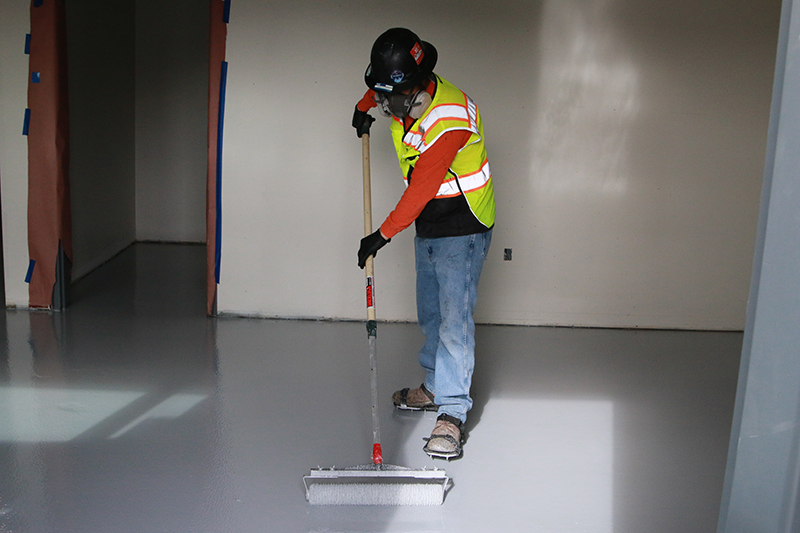
This case study features the following:
- High school is located in an urban Southern California area with more than 3,000 students.
- Due to onsite pesticide use, a vapor intrusion mitigation system was necessary to protect students and staff.
- The vapor barrier was applied throughout the 14,000 square foot library building located on-campus.
Client Spotlight: Garnet Johnson, Director of Remediation Services at Triterra
 For Garnet Johnson, Director of Remediation Services at Triterra, an environmental consulting firm based in Lansing, MI, a career path leading to environmental remediation began with a different destination, but ultimately, he’s happy where his professional journey has since taken him. That’s because Johnson, who joined Triterra in 2017, did not initially plan on a career in environmental remediation when he entered college. He shares, “I earned my BS in Biology with an Environmental Studies minor from Alma College in 2003, and started out in the Due Diligence industry doing Phase I projects for cell phone towers throughout the U.S. As my experience and career progressed, I focused more towards Phase II work and Leaking Underground Storage Tank sites. Looking back, it is amazing to see my path to Director of Remediation Services at Triterra, and it’s one that I feel fortunate to have followed.” Prior to working at Triterra, Johnson was an Environmental Scientist for a consulting firm, a Project Professional with a civil engineering firm, and prior to that served as a Project Manager at an environmental services firm. He continues, “I began working in the environmental industry in 2003 and travelled across the country completing Phase I ESAs in 39 different states over an 18-month period. I decided in 2005 that the travel was too extensive and accepted a position at an environmental consulting firm with specialization in leaking underground storage tank sites. Since that time, I have focused on both due diligence services and leaking underground storage tank sites.” In his role at Triterra, Johnson manages the firm’s Remediation and Investigation Group Staff, which primarily includes overseeing investigation and remediation projects, mentoring staff, and attracting new clients. He continues, “What I enjoy most about my job is working with the staff and creating unique solutions for complex problems. It is very rewarding to know that our solutions are often the key to making a development project feasible.”
For Garnet Johnson, Director of Remediation Services at Triterra, an environmental consulting firm based in Lansing, MI, a career path leading to environmental remediation began with a different destination, but ultimately, he’s happy where his professional journey has since taken him. That’s because Johnson, who joined Triterra in 2017, did not initially plan on a career in environmental remediation when he entered college. He shares, “I earned my BS in Biology with an Environmental Studies minor from Alma College in 2003, and started out in the Due Diligence industry doing Phase I projects for cell phone towers throughout the U.S. As my experience and career progressed, I focused more towards Phase II work and Leaking Underground Storage Tank sites. Looking back, it is amazing to see my path to Director of Remediation Services at Triterra, and it’s one that I feel fortunate to have followed.” Prior to working at Triterra, Johnson was an Environmental Scientist for a consulting firm, a Project Professional with a civil engineering firm, and prior to that served as a Project Manager at an environmental services firm. He continues, “I began working in the environmental industry in 2003 and travelled across the country completing Phase I ESAs in 39 different states over an 18-month period. I decided in 2005 that the travel was too extensive and accepted a position at an environmental consulting firm with specialization in leaking underground storage tank sites. Since that time, I have focused on both due diligence services and leaking underground storage tank sites.” In his role at Triterra, Johnson manages the firm’s Remediation and Investigation Group Staff, which primarily includes overseeing investigation and remediation projects, mentoring staff, and attracting new clients. He continues, “What I enjoy most about my job is working with the staff and creating unique solutions for complex problems. It is very rewarding to know that our solutions are often the key to making a development project feasible.”
When it comes to working with Land Science®, Johnson feels the company’s suite of products address a wide range of needs and challenges. “With regard to vapor intrusion”, he says, “Land Science has an effective solution for anything we’ve encountered, or likely will encounter relating to vapor intrusion. As an example, we had a very public project with a high-level of scrutiny from our governing agencies. Land Science was an invaluable partner and helped solve numerous complex vapor intrusion issues with the added pressure of looming construction deadlines and public review.” He adds, “I look forward to continuing to work with them on many projects in the future.”
Currently, Triterra uses Land Science vapor barrier systems at most of its new construction sites requiring vapor mitigation, due to their constructability under various scenarios. He shares, “Most important is the testing data that supports chemical resistant requirements established by the State of Michigan, and ultimately knowing that our clients can provide a safe environment for their customers. We are looking forward to the advantages Nitra-Seal® and TerraShield® can offer to the market.” He also looks forward to continuing to assist Triterra in achieving its goals, both long-term and short-term, and notes that the company has grown an average of 25% each year for the last 10 years. He continues, “We would like to maintain that consistent healthy growth. One of our biggest strengths is our office culture, and as a leadership group we have agreed that we want to maintain our healthy ‘family style’ culture. Prior to working at Triterra I was working from home. I was not looking to change that situation when Triterra approached me, however, I fell in love with the work environment here. Although my work has its challenges, it is much more enjoyable to work on those challenges with a group of people you enjoy being around.” To stay abreast of the latest industry trends and technologies, he regularly attends webinars, presentations and conferences. “We can’t provide the most comprehensive solutions to our client’s problems if we don’t know all the options that are available.”
Johnson resides in Alma, MI, and works out of Triterra’s Alma, MI office. He and his wife have three children. He shares, “All of our kids are active in youth sports and are currently learning to play piano. For family activities we enjoy summer camping trips and have a 3-acre pond on our property where the kids spend much of their summer break swimming, fishing and catching frogs. Our family garden provides us with most of our vegetables throughout the year. In addition, we added two beehives two years ago and we were able to harvest about 5 gallons of honey last year. My own hobbies include hunting, fishing, camping, running and most other outdoor activities.” He also serves as a volunteer softball and baseball coach for his community’s local youth programs. In addition, he and his family are very involved with their local school’s weekend backpack program that provides food for children who might not otherwise have anything to eat over the weekends.
When asked how he’s seen the industry change over the years, he feels new technology continues to play a vital role. “The environmental industry is always changing. We must be prepared to advance with all the new technologies and the ever-changing landscape of contaminant discovery and risk assessment.” And how would he encourage others to join in his field of study? He concludes, “I would suggest that anyone interested in our industry reach out to local consulting firms and ask a lot of questions. Anything to help build that relationship with people who are working in the field is a big help. I’ve found that many in our industry are happy to share their knowledge with other people. In addition, the answers to those questions can be used to help guide in your class choices and even help make decisions as to which area of consulting is of the most interest.”
Land Science is proud to have Garnet Johnson, Director of Remediation Services at Triterra, as a valued client and partner in environmental remediation, and appreciates his diverse background and approach in providing successful remediation outcomes for Land Science and its clients.



